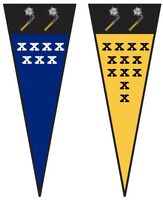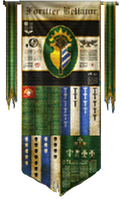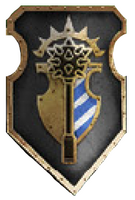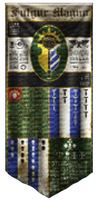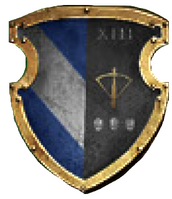The Legio Astraman ("Morning Stars") is a Loyalist Titan Legion of the Collegia Titanica.
The Legio Astraman is based on the Forge World of Graia. They guard the Belt of Iron, the name given to a region of space spanning the Segmentum Tempestus and Segmentum Pacificus that was home to many less potent Forge Worlds.
Legion History[]
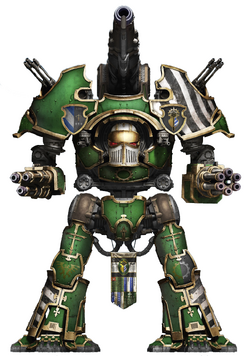
The Legio Astraman Warbringer-Nemesis-class Titan Fulgur Magno displaying the Legio's colours.
Origins[]
The history of the Forge World Graia and the Legio Astraman is intrinsically linked to the Belt of Iron, a name given to a region of space spanning the border sectors of the Segmentum Tempestus and Segmentum Pacificus which contained numerous lesser Forge Worlds. When the colony arks sent forth from Mars during the Age of Strife reached the planet that would become the Forge World of Graia, they found a world overrun by warring tribes of Feral Orks. Though the presence of the xenos made initial attempts at colonisation far from simple, it also proved to be the first test of the yet-unnamed Titan Legion that would come to form the basis of the Legio Astraman.
The exact origin of the name "Morning Stars" is unknown and unrecorded, bar that it was bequeathed upon the Legio Astraman during the colonisation of the Forge World. Speculation as to the provenance of the name makes reference to fragmented reports of battles that took place during initial landfall upon the planet, with data-fragments stating that "...preceded by thunderous steps they came...striding forth haloed by the first rays of sun...and lo did the creatures blister and burn, as the wrath of the Omnissiah shone like a star amongst their ranks."
It was the strength of the Legio Astraman that ensured Graia thrived during the Age of Strife, expanding its reach to over two dozen star systems by the time contact was made with the newborn Imperium of Man in the late 30th Millennium.
The Morning Stars' success can be attributed to three defining factors. The first was the construction of an extensive network of manufactoria that were capable of producing Titans, allowing the expansion of the Legio Astraman to a size equivalent to that of a Primus-grade Titan Legion. Secondly, its tenacity and firm resolve, for which the Legio Astraman quickly became known during the Great Crusade, bred a Titan Legion capable of overcoming the numerous threats they faced.
Lastly, the magi of Graia laboured for standard centuries to construct a network of orbital platforms around the Forge World, each bristling with weapons while offering additional residential and research capacity, should it be required. This network became known as the "Crown of Graia" and served to alleviate the need for large numbers of Morning Stars god-engines to remain deployed in defence of the Forge World, allowing the Legio's strength to be focussed on Graia's more distant holdings.
Thus, when the Great Crusade finally began its expansion into the Segmentum Pacificus, it found a prosperous "Forge Empire" defended by a Titan Legion of considerable size.
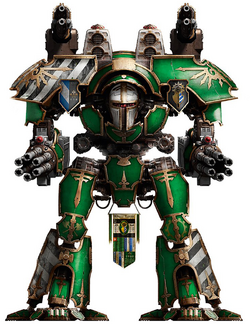
Legio Astraman Warlord-class Titan Fortiter Bellator during the Horus Heresy.
The strength of the Legio Astraman ensured that initial contact between Graia and the Imperium was tense, for the representatives of the Emperor voiced concerns that any attempt to conquer the Forge Empire of Graia would be a protracted and bloody affair. It was with much relief to such individuals that Graia appeared willing to join the Imperium with minimal resistance and, in return for their service, the Forge Empire was granted feudal rights to an additional handful of star systems which the Imperium had already conquered.
The rediscovery of Graia proved advantageous for the Imperium as the Titan Legion's god-engines were sorely tested in the solar decades following the Forge World's rediscovery.
Expansion across the region of space that would eventually become known as the "Belt of Iron" saw the Imperium encounter many Forge Worlds of varying strength, some of which were protected by Titan Legions of their own.
The first such world to be encountered after Graia was the Forge Empire of Valia-Maximal and the now-infamous Titan Legion known as the Legio Laniaskara ("Impalers") that defended it. Unlike Graia, the people of Valia-Maximal were not open to Imperial Compliance and opposed the Imperium with all their might. Though Valia-Maximal eventually fell, it did so only after a protracted campaign in which the Morning Stars and the Impalers inflicted considerable damage upon one another, which in turn inflicted irreparable damage upon the diplomatic relationship between the two Forge Worlds.
Further conflict with dissident Titan Legions, such as the Legio Venator, was not uncommon during the Imperial conquest of the two segmentums, though it was not the sole war front on which the Legio Astraman fought during the Great Crusade.
Indeed, the Morning Stars soon earned themselves a name serving alongside the Raven Guard Legion, thanks in part to the Titan Legion's overreliance on data-predictions to dictate their tactics which enabled them to proactively support the clandestine nature of the Raven Guard's preferred tactics.
Horus Heresy[]

A Legio Astraman Titan maniple consisting of a Reaver-class Titan flanked by a pair of Warhound Scout Titan during the Horus Heresy.
By the time of onset of the Horus Heresy in the early 31st Millennium, the Legio Astraman was perhaps one of the foremost experts in fighting other Titan Legions, thanks largely to their participation in the conquest of various Renegade Forge Worlds, marking them out as a potentially significant threat in the war to come.
Presuming the loyalties of Graia would be difficult to gain, emissaries of the Warmaster Horus instead turned Valia-Maximal to their side, stoking the fires of resentment and placing the two long-antagonistic Forge Worlds in direct opposition.
When the latter publicly declared for the cause of the Warmaster, Graia found itself pulled into an escalating conflict with Valia-Maximal and its Legio Laniaskara, leading to the recall of much of the Morning Stars' strength. Their numbers proved valuable following the eruption of full-scale war across the Belt of Iron.
Over two-thirds of the strength of the Legio Astraman was committed to the region and the resulting conflict, known as the Cataclysm of Iron, was to see hundreds of worlds devastated, with even Graia itself feeling the tread of Traitor god-engines when the Legio Laniaskara fell upon the Forge World.
What strength the Legio Astraman held elsewhere in the galaxy soon found itself drawn into the deadliest conflicts of the Horus Heresy, including the chaotic maelstrom of the Beta Garmon campaign.
Post-Heresy[]
In the dark days following the fall of Horus at the Siege of Terra, it was the Morning Stars that discovered Valia-Maximal abandoned, the once-prosperous Forge World left barren save for the desecrated husks of those Morning Stars Titans that had fallen during the conflict, unable to be retrieved.
Since that day, the Legio Astraman has vowed to pursue the Legio Laniaskara to the end of the galaxy, until such a time as its memory has been banished.
Notable Campaigns[]
- Battle of Beta-Garmon, "The Titandeath" (006-013.M31) - The Legio Astraman took part in the long and savage Beta-Garmon campaign, which included hundreds of war zones across dozens of worlds. During this conflict, the Legio Astraman was supported by the Knights of House Moritain. Even before the greater armies of the Warmaster Horus reached the star cluster, the battle lines had long since been drawn, and fighting had been going on for many Terran years. It was a cauldron of battle that would consume millions of lives before its end and see the demise of entire Titan Legions, earning this campaign the dire moniker of the "Titandeath." The Beta-Garmon Cluster, also known as the gateway to the Throneworld of Terra, was the last hurdle that the Warmaster Horus' forces had to overcome before they reached the Imperium's capital world. Heavily fortified by the Loyalists, Beta-Garmon would become one of the greatest and bloodiest battles of the Horus Heresy, as well as one of the longest-lasting.
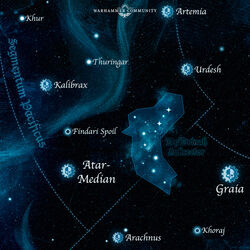
Map depicting the region of Imperial space known as the "Belt of Iron" during the Horus Heresy.
- Cataclysm of Iron (010-015.M31) - Across border sectors of the Segmentum Tempestus and the Segmentum Pacificus are located numerous lesser Forge Worlds known collectively as the "Belt of Iron." Since the sundering of the Imperium, many declared for the Traitor cause at the engineering of the fabricator-general of Mars, while others remained loyal to Terra or sought to remain as aloof as possible from the conflict. Strife and tentative conflict between these once-aligned worlds erupted into full-scale war in 010.M31, pitching the Mars-aligned Forge Worlds of Incunabula, Urdesh, Valia-Maximal and Kalibrax against the forces of the Loyalist worlds of Graia, Arl'yeth and Atar-Median, while Arachnis and Jerulas Station both fell into civil war. The resulting conflict, later known as the "Cataclysm of Iron," saw the forge lords, their armies and allied Titan Legions and Knight houses turn on each other in protracted warfare, with scores of Human-inhabited worlds in the region suffering as they became the battlegrounds upon which they fought.
- Battle of Pioro III (010.M31) - By 010.M31, all communication with Jerulas Station had ceased, while the Forge Empire of Arachnus closed its borders as its people argued amongst themselves, unable to decide if they should aid the Imperium or forge their own path. Upon Pioro III, 14 Titans were felled as the clashes between the Legio Laniaskara and Legio Astraman escalated. Of the millions caught in the crossfire, few survived.
- Invasion of Ny'Drinah (302.010.M31-552.010.M31) - Navigation records extracted from the databanks of the Paradonal fleet anchorage, located within the Ny'Drinah Sub-sector, note that Warp disturbances, suggesting the movement of a significant number of vessels heading towards the system, were detected 17 solar standard days after Atar-Median first entered the Findari Spoil. Mere solar hours later, several hundred vessels, bearing the livery of both Urdesh and Kalibrax, emerged from the Warp within the Paradonal'ny System, obliterating its defence stations with minimal losses and laying claim to the fleet anchorage. Acting upon preordained strategies, the Traitor Forge Worlds moved to lay claim to the valuable worlds of the Ny'Drinah Sub-sector. The subsequent conquest of the sub-sector proved swift. Having secured a base of operations through their capture of the Paradonal'ny System, the Traitor fleet moved to seize their secondary targets. The core of the Traitor force consisted of Titans drawn from both the Legio Damicium and Legio Kulisaetai, of which varying strength estimates place as between 25 and 70 Traitor god-engines committed to the conquest and whose considerable might far outstripped the defenders scattered across the Ny'Drinah Sub-sector. This timing was no doubt meant to exploit laws which ensured that only a token force from each petitioning Forge World was allowed entry to the sub-sector, lest accusations of external pressure influencing the negotiations be levied against the process. In accordance with such an edict, less than a decad of Loyalist Titans, consisting of a mixture of Legio Atarus, Legio Venator and Legio Astraman god-engines, stood within the sub-sector when the Traitors began their invasion and represented the sole force capable of besting an assault led by a Titan Legion. Facing a Traitor force capable of assaulting several worlds at once, the Loyalist Titans were quick to accept the inability of their numbers to defend the entire sub-sector and redeployed to the Xiloci'ny System, mustering to defend the sub-sector's capital world and await relief from allies further afield.
- Conquest of Xiloci II (O10.M31) - In the solar weeks following the fall of the Paradonal'ny System, the Traitors secured their hold upon the Ny'Drinah Sub-sector, seizing control of four further systems before attempting to conquer the Hive World of Xiloci II. Here, the Traitor advance stalled, their Titan Legions contested by the considerable defenses of the hive cities and the valiant retaliation of the vastly outnumbered Loyalist Titans. In an effort to break the developing stalemate, those worlds captured by the Traitors were turned towards fuelling the conquest of Xiloci II. By 552.010.M31, only the Xiloci'ny and Uridoci'ny Systems remained defiant in the face of invasion, with their worlds dispatching frequent calls for aid.
- Turning Point (874.010.M31) - The main Loyalist force, dispatched from Graia with two demi-legios of Legio Astraman god-engines and commanded by Magos Dominus Xixos, chose the Uridoci'ny System as their first target. On Uridoci VI, a mining world reliant upon the exploitation of phosphorite deposits, a solar month-long conflict between the Legio Astraman and Legio Kulisaetai brought the world's industry to ruin, with eight Titans felled, and 13 others requiring extensive repair. The final blow for the Traitors came upon the Agri-world of Uridoci III. Against the small garrison of Gatekeeper Titans, Graia sent a score of Morning Stars in a show of overwhelming strength designed more as a symbolic gesture than a tactical necessity. In an act of spiteful retaliation, the Impalers refused to meet the Loyalists in open battle, instead detonating hundreds of nuclear warheads across the surface resulting in a radical change in the planet's atmosphere and the death of the world's entire population. This act proved tailored to demoralise the resistance of those still loyal to the Emperor across the Belt of Iron, with the death of Uridoci III broadcast across the region as a warning to any who stood against the Warmaster Horus.
- Relief of Xiloci II (924.010.M31) - The main objective of the Loyalist force was the seizure of Xiloci II, reasoning that, by securing the sub-sector's capital, they would rob the Traitors of the ability to secure victory within the region. To this end, three detachments of Legio Astraman Titans, numbering a total of 25 god-engines, landed upon Xiloci II within landing zones secured by Loyalists already embedded upon the surface. In response, the Traitors moved their forces to secure their siege lines, creating reinforced fortifications around unconquered hive cities. In doing so, the Traitors sacrificed their momentum, forming isolated pockets of resistance which the Loyalists could attack at their leisure. Capitalising on this, the Legio Astraman led a campaign of methodical conquest, forming three prongs that assailed hive cities in close proximity to prevent the Traitor positions from reinforcing one another. The resulting conquest recorded only minimal losses for the Legio Astraman, with the Morning Stars relying upon maniples consisting largely of Reavers and Warlords capable of engaging the strongest elements of the Legio Kulisaetai and pushing through to break open Traitor lines. After three solar months of protracted warfare, the Traitors were ousted from much of Xiloci II, with their ground forces holding only a handful of hive cities after Kalibrax had evacuated the surviving elements of the Legio Kulisaetai. The last resistance to Loyalist control was quashed after a determined assault upon the hive city of Tartunrus Spyre which Xixos himself took part in, directly commanding the conflict from within the Morning Stars Warlord Titan Grace of Wrath. Unwilling to expend time and lives upon another siege, the fate of Tartunrus Spyre was sealed when the guns of the Legio Astraman were turned upon the mountain around which the city was constructed, burying it beneath an avalanche of stone. Once dominion over Xiloci II was secured, the Knights of House Col'Khak were tasked with rooting out any remaining resistance while Xixos committed his forces to regaining control of the remaining worlds within the Xiloci'ny System and beyond.
- Siege of Graia (441.011-642.013.M31) - The conflict across the Belt of Iron was not confined to the Ny'Drinah Sub-sector during the opening years, and in the eastern area of the region the sporadic conflict between Graia and Valia-Maximal had escalated into all-out war. The advantage lay firmly with Valia-Maximal, for a significant portion of Graia's forces were committed both to the conquest of the Ny'Drinah Sub-sector and the escalating conflict within the Beta-Garmon System. The role Graia played in the conquest of Valia-Maximal during the Great Crusade is well recorded, as are the numerous denied petitions by Valia-Maximal demanding reparations for the damage the Morning Stars inflicted upon their world. In a desire to claim vengeance for such losses, Valia-Maximal unleashed its forces upon three star systems neighbouring Graia, conquering them in swift succession and denying the Loyalists access to several well-developed, industrial worlds that aided the production of additional Morning Stars god-engines. In response, Graia swiftly dispatched maniples to the three systems while also recalling much of their forces committed elsewhere in the galaxy, forcing their allies to finish the conquest of the Ny'Drinah Sub-Sector. However, unknown to the Loyalists, the Traitors made their true intentions known when they moved upon Graia itself. Though devoid of much of its fleet and Titan Legion, Graia was not left defenceless, with its network of orbital defences capable of leveraging considerable firepower against the invading fleet. To counter this, Valia-Maximal had refitted several of its battleships with heavily modified Nova Cannon intended to outrange Graia's orbital stations. As the battle raged in orbit, a strike force of Legio Laniaskara Titans was unleashed upon the Forge World itself, securing a wide swathe of forge-fanes before an efficient defence could be mustered. Attempts to land additional ground forces proved unworkable, with some reports suggesting movement amongst the network of space stations, despite no record of their capability to do so, in direct counter to Traitor fleet movements. In time, the Traitor fleet retreated from the Graia System, leaving over 30 Legio Laniaskara Titans deployed upon the Forge World that engaged in a sustained campaign of destruction across the surface of Graia.
- Protectorate of Unsubdued Steel (584.011.M31) - Those split between loyalty to the Emperor and the Warmaster were not the sole combatants during the Cataclysm of Iron. Across the galaxy all manner of lost, destitute and abandoned souls looked for new purpose, with many choosing to forgo swearing allegiance to any but themselves. Within the Belt of Iron, the Forge World of Arl'yeth became a target for one such opportunistic force after many of the Legio Astraman Titans left to defend the world were recalled in response to the invasion of Graia. Soon after, Arl'yeth was amongst the first to feel the tread of Titans sworn to a rising Forge Empire known as the "Protectorate of Unsubdued Steel." Thirteen Titans, bearing the defaced livery of seven different Titan Legions, including the Legio Astorum and Legio Damnatus, landed upon Arl'yeth, demanding the planet's subservience and threatening conquest if refused. Though Arl'yeth proved steadfast in its defiance, the world itself was guarded by ill-experienced battalions of Mechanicum Taghmata supported by three Legio Astraman god-engines. Six solar hours after battle was joined, the final Morning Stars Titan fell to the guns of the invading engines and Arl'yeth surrendered, joining over a dozen other worlds that had previously been incorporated within the Protectorate. In the solar months following the fall of Arl'yeth, multiple encounters with Titans associated with the fledgling Forge Empire were reported, many of which are noted to have quickly escalated into violence as the Protectorate sought to expand their domain.
- Battle of Paradonal'ny (012.M31) - The Loyalists assailed the Paradonal'ny System, committing 50 Titans, of both the Legio Atarus and Legio Venator, to besiege the Traitors entrenched around the orbital elevator upon Paradonal I linked to the fleet anchorage in orbit. The subsequent siege, which saw 18 Titans fall, ended when the Traitors turned their guns upon the orbital tether itself, severing the link between the fleet anchorage and the planet. The resulting debris fell upon the Traitors' position, claiming the life of Magos Dominus Xixos and nine Loyalist Titans along with the few remaining Traitor Titans while causing catastrophic damage to the planet's biosphere. This final act of spite, committed as the remaining Traitors withdrew, left the Loyalists in control of a ravaged sub-sector, its industry and populace severely reduced when compared to its pre-invasion status; censuses taken two solar decades after the invasion of the sub-sector report a 64% decrease in population, and 76% decrease in industrial output, relative to the numbers recorded before the Horus Heresy began. Though no longer capable of supplying the Loyalist Forge Worlds as it once had, the sub-sector still proved strategically viable, not least because it awarded the Loyalists a stronghold from which they could assault the Traitor Forge Worlds directly. Importantly, victory within the sub-sector also served to shore up the morale of the Loyalist forces, prompting many across the Belt of Iron whose allegiance had previously been undetermined to announce their support for the Emperor, undermining the Traitors' attempts to find new allies.
- Battle of Nariindi (012.M31) - Throughout the Cataclysm of Iron, the vital Agri-world of Nariindi, one of the principal suppliers of food to the Forge World of Graia, was plagued by widespread rebellion. This resulted in several maniples of Legio Astraman Titans being deployed to placate the world. Contact was lost in 012.M31, and it was only upon the rediscovery of the some of the hollowed-out shells of Legio Astraman Titans upon the abandoned Forge World of Valia-Maximal two standard years later that their fate became known.
- Censure of Urdesh (149.012.M31-856.012.M31) - The fall of the Ny'Drinah Sub-sector secured a nexus of industry that, though severely damaged, proved sufficient enough to facilitate the rapid refitting of the Loyalist Titan Legions in preparation for the next stage of conquest. Although numerous conflicts raged across the Belt of Iron, the Loyalists set their sights upon the Traitor-held Forge Worlds of Urdesh and Arachnus. The assault upon Urdesh was not solely motivated by the desire to punish the Traitors, for messages from Terra itself had reached Graia calling for the censure of the planet for its efforts in ferrying supplies to the Segmentum Solar. The force dispatched by Graia in answer to these calls included over 40 Morning Stars god-engines and 60 Knights of House Moritain within their number, yet those upon Terra dared not risk the failure of such an important mission. To this end, assistance was sent both in the form of martial strength, with Terra dispatching an octad of Legio Ignatum god-engines, redeployed from the outer sphere of defences across the Segmentum Solar, to Urdesh and relating broadcast codes, gathered by agents of Malcador the Sigillite scattered throughout the galaxy, that masked the Loyalist approach as a fleet under service to the Warmaster rather than sworn to Graia. Such duplicity proved worthwhile for the arrival of Graia's fleet caused no alarm upon Urdesh, its people celebrating the apparent arrival of allies to help in the conquest of the region. En masse, the Loyalist landing craft descended upon the world, directed to landing zones across the surface of the Forge World. Having inadvertently invited their foe onto their world, the ruling caste of Urdesh gathered to greet the representatives of the Warmaster, flanked by a token guard drawn from the Legio Damicium. Their attempts at hospitality were met with death, Morning Stars Titans standing proud before the Traitors as the landing vessel ramps lowered and, with a single devastating salvo, eradicated the upper echelons of Udresh's leadership. Across the Forge World, similar scenes played out and in quick succession a series of landing zones had been secured by the Loyalists, allowing further reinforcements to be ferried to the surface. The complete subjugation of Urdesh proved far more troublesome.
- Onwards: Silence Amongst the Stars (211.013-461.014.M31) - The siege of Arachnus, fall of Urdesh and blockade of Kalibrax all but brought an end to the Traitor threat within the Segmentum Pacificus region of the Belt of Iron. The Belt of Iron was not free of war, however, for Graia remained locked in seemingly endless war against Valia-Maximal. The Loyalist Forge World had suffered greatly at the hands of the Traitors as Legio Laniaskara Titans still walked the surface of Graia while others of their ilk brought death down upon the world they had sworn to protect. The Loyalists faced a methodical campaign of attrition orchestrated by Magos Dominus-Alpha Hieroneyum that sought to disperse the strength of Graia through a series of feints and rapid assaults. It was only with the death of Hieroneyum upon the industrial world of Nalindeer that the tide of war turned, the traitorous magos killed when a trio of Morning Stars Warhound Titan, bearing the names Forge Beast, Faithful Sire and Venator Ultima, sacrificed themselves to destroy the Ordinatus Valia within which he rode to war.
- Imperial Muster at Beta-Garmon (012-013.M31) - For reasons only understood later in the war, the Ruinstorm that had been invoked by Lorgar, primarch of the Word Bearers, several standard years earlier during the Battle of Calth, began to abate across vast swathes of the galaxy. Loyalist high commanders were able to utilise the potent astropathic relay at Beta-Garmon to contact and recall formerly lost or stranded forces from across the war-torn reaches of the northern Imperium. The Imperial Muster at Beta-Garmon rapidly escalated into the largest gathering of Loyalist might since the early years of the war, a concentration of forces so mighty that the Traitors had to respond in kind. The resulting clash of arms would become known as the Great Slaughter, a theatre of war of such scale that it would encompass the "Titandeath" and the Sea of Fire campaigns, each major campaigns in their own right. By its end, both sides were so badly bled that their only remaining option for ultimate victory was to force a final, decisive confrontation. As history related, the final battle would be fought at Terra, but only after the weighty butcher's bill of the Great Slaughter was paid in full.
- Reconquest of the Forsarr Sector (999.M41) - Three standard years after the fall of the sector's vital Hive World capital of Forsarr in the Segmentum Tempestus, the Administratum finally recognised the true threat posed by WAAAGH! Garaghak. The Aurora Chapter joined a powerful coalition with their brethren of the Revilers and the Death Eagles as well as a demi-legio of Titans of the Legio Astraman and several regiments of Astra Militarum and Ecclesiarchal troops. They took the fight to the Orks and reclaimed the Forsarr Sector for the Emperor. It is unknown if the fact that the Raven Guard's homeworld of Deliverance is also located in the Forsarr Sector prompted this deployment.
Legion Combat Doctrine[]
Like all military forces drawn from Graia, the Morning Stars possess an innate tenacity and refusal to yield, never retreating, even in the face of certain death. The princeps of the Legio Astraman are trained to operate with reduced systems, pushing them to better understand the limitations of their god-engines. The iron will of their princeps are legendary and nothing can dissuade them from their chosen path.
They are careful to ensure their assigned god-engine is always operational at peak condition, monitoring all systems even in the heat of battle. They also believe in facing adversity head-on and will not baulk in the face of a charging foe.
Notable Titans[]
- Fortiter Bellator (Warlord-class Titan) - Titans were engineered to be capable of facing any threat the wider galaxy could throw at them, and loadouts such as that displayed by Fortiter Bellator, displayed above, were common when called upon to face enemy infantry. Fortiter Bellator took part in the campaign upon the Agri-world of Nariindi, one of the principal suppliers of food to the Forge World of Graia. The Agri-world was plagued by widespread rebellion during the Cataclysm of Iron, resulting in a maniple of Titans, including Fortiter Bellator, being deployed to placate the world. Contact was lost in 012.M31, and it was only upon the rediscovery of the gutted carcass of the Warlord upon the abandoned Forge World of Valia-Maximal two standard years later that its fate became known.
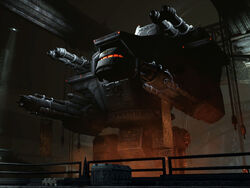
The Warlord-class Titan Invictus under construction on Graia in the 41st Millennium.
- Invictus (Warlord-class Titan) - One of the major strategic targets of interest for the Ork WAAAGH! Grimskull during its invasion of Forge World Graia was the seizure of the Warlord-class Titan Invictus that was nearing completion in the Ajakis Manufactorum. Much of the effort of the Ultramarines 2nd Company under the command of Captain Demetrian Titus that was deployed to Graia to slow down the Orks' advance until an Imperial liberation fleet could arrive was directed towards the defence of this nascent Titan from seizure by the Greenskin invaders. Invictus was later used by the Imperial forces to destroy the major focal point on Graia from which the forces of Chaos were launching their own invasion of the Forge World, by use of a Volcano Cannon supercharged with the mysterious Warp-based power source that had been developed by Inquisitor Drogan.
- Fulgur Magno (Warbringer-Nemesis-class Titan) - Though the Morning Stars contributed forces to conflicts throughout the Belt of Iron and the wider galaxy during the Horus Heresy, much of their efforts focused on halting the advances of the hated Legio Laniaskara into the borders of Graia's Forge Empire. Given the infamously direct tactics of the Impalers, those in command of Morning Stars forces relied heavily upon defensive strategies in response. Warbringer-Nemesis Titans, such as the Fulgur Magno depicted above, were vital elements of such tactics, often being used as anchors for a defensive line. Faster elements of the Legio Astraman would draw Impalers god-engines into carefully prepared kill zones where the Traitors' movements were slowed by the debilitating effects of the Morning Stars' Quake Cannon.
Notable Personnel[]
- Princeps Enoch - Enoch was the princeps of the Warlord-class Titan Invictus under construction on Graia in the 41st Millennium and later commanded it in battle.
Legion Specific Wargear[]
- Maglock Shells - Legio Astraman Titans make use of modified ordnance designed to adhere to the armour of their target before detonation, localising the damage for greater impact.
Legion Allies[]
Knight Houses[]
Space Marines[]
Legion Strength[]
The strength of the Legio Astraman benefited greatly from both the manufacturing capacity of Graia and the Imperium's need to sustain their numbers in conflicts with enemy Titan Legions during the Great Crusade, such as the Legio Laniaskara and the Legio Venator.
To ensure that the attrition of such conflicts did not wear down the Morning Stars' numbers, over a dozen lesser Forge Worlds in close proximity to Graia were tasked with supplying the Legio Astraman with materiel and, where possible, Titans. Through careful negotiation, this flow of resources was maintained until the outbreak of the Horus Heresy which saw the strength of the Legio Astraman stand at 156 god-engines, marking it as a Primus-grade Legio.
Given the ancient status of this Titan Legion, several of these were of rarer classes including at least three Imperator Titans, of which one fell upon Urdesh and has yet to be rebuilt. Of the remaining Titans, the Morning Stars showed a preference towards the deployment of Warlord Battle Titans, with nearly half their number drawn exclusively from its ranks.
The remaining god-engines utilised by the Legio Astraman were split evenly between Scout and Battle Titans, with numbers of both maintained at equivalent levels to ensure the Titan Legion could adapt to any situation.
Legion Appearance[]
Legion Colours[]
The colours of the Legio Astraman are green, yellow and blue; decoration is sometimes added in white and blue (usually stripes or checker-patterns).
Legion Badge[]
The iconography of the Legio Astraman Titan Legion is a black morning star outlined in gold, centered upon a shield which is half gold, and half blue and white chevrons.
This central icon is crowned by a golden Iron Halo and centered upon a field of green.
Sources[]
- Adeptus Titanicus - The Horus Heresy: Loyalist Legios (Specialty Game), pp. 88-93
- Adeptus Titanicus - The Horus Heresy: Crucible of Retribution (Specialty Game), pp. 22-23, 26-27, 29-31, 72-73, 76-77
- Adeptus Titanicus - The Horus Heresy: Rulebook (Specialty Game), pg. 16
- Adeptus Titanicus - The Horus Heresy: Titandeath (Specialty Game), pg. 93
- Codex Titanicus (1st Edition), pg. 110
- Imperial Armour Volume One - Imperial Guard & Imperial Navy, pg. 8
- Imperial Armour Volume Eight - Raid on Kastorel-Novem, pg. 77
- The Horus Heresy - Book Six: Retribution (Forge World Series), pg. 31
- White Dwarf 108 (UK), "'Eavy Metal: Adeptus Titanicus Titans & Banners," pg. 76
- Warhammer 40,000: Space Marine (Video Game)
- Warhammer Community - Crucible of Retribution: The Story (23 Oct 2020)
- Warhammer Community - Coming Soon: Crucible of Retribution (29 Sept 2020)


